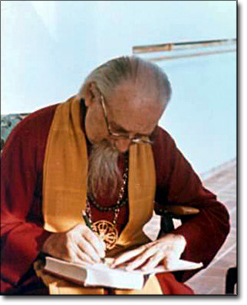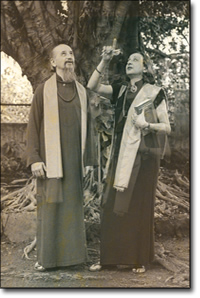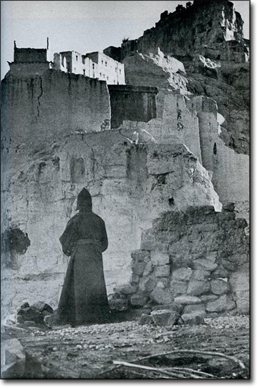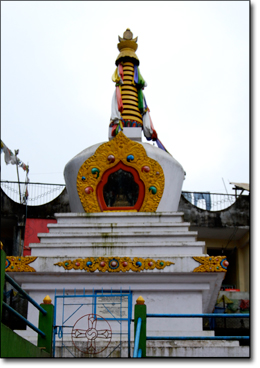Lama A. Govinda
The founder of the Arya Maitreya Mandala
Early Life
Lama Anagarika Govinda (1898-1985), the founder of the Arya Maitreya Mandala, was a scholar, mystic, writer, painter and poet. As Robert Thurman remarks, Lama Govinda is "undoubtedly one of the West’s greatest minds of the twentieth century, among the Pantheon that includes with Einstein, Heisenberg, Wittgenstein, Solzhenitsyn, Gandhi, and the Dalai Lama." (Introduction to The Way of the White Clouds).
Govinda was born 1898 as Ernst Lothar Hoffman in Waldheim, Kingdom of Saxony, the son of a German father and a Bolivian mother. At the age of 16 he started a comparative study of philosophy as well as the major religions and encountered Buddhism. He became a Buddhist at the age of 18. While enrolled in the German army during World War I, he caught tuberculosis and recovered at a sanatorium. He studied philosophy, psychology and archaeology at Freiburg University.
From 1920 until 1928 Govinda was living on the island of Capri (Italy), as a painter and poet. While staying in Capri he also started a serious practice of Buddhist meditation according to the Pali-Tradition. At that time he studied at the Universities of Naples and Cagliari and made archaeological research journeys in North Africa.
In 1928 Govinda moved to Ceylon and stayed with Nyanatiloka, a teacher and scholar in the Theravada tradition of Buddhism. Govinda founded the Variyagoda Hermitage in the mountains near Gampola, where he studied Pali language and the philosophy of Abhidhamma. He became the founder-secretary of the International Buddhist Union, which aimed to promote Buddhism worldwide.
India
As the representative of the International Buddhist Union, Govinda attended 1931 the All-India Buddhist Conference in Darjeeling. Here he met the Tibetan Gelugpa master Lama Ngawang Kalzang, also known as Tomo Geshe Rinpoche I (1866–1936), who became his teacher in meditation. In 1932 Govinda visited Tibet from Sikkim, and in 1933 from Ladakh.
To live closer to his teacher Ngawang Kalzang, Govinda stayed on in India, teaching European languages and Buddhist culture at Rabindranath Tagore’s Vishva Bharati University in Shantiniketan. His lectures on Buddhist architecture at Shantiniketan were published as the book Psycho-Cosmic Symbolism of the Buddhist Stupa.
In 1933, inspired by Lama Ngawang Kalzang, Govinda founded the Order of the Arya Maitreya Mandala and initiated fourteen people into the order. In 1934 Govinda had a successful exhibition of his paintings in Calcutta. Since 1935 he served as the general secretary of the International Buddhist University Association. At the Buddhist academy at Sarnath he held lectures on philosophy, history and archaeology. In 1936 Govinda became a lecturer at the University of Patna. His Patna Lectures on Abhidhamma were published in 1939 as The Psychological Attitude of Early Buddhist Philosophy. Govinda also gave guest lectures at the universities of Benares, Allahabad und Lucknow.
Although Govinda became a citizen of British India in 1938, the British nevertheless interned him during World War II due to his associations with important personalities of the Indian independence movement like Jawaharlal Nehru. During his years in the internment camp at Dehra Dun, Govinda stayed with the German monk Nyanaponika, with whom he translated Buddhist texts and studied Asian languages.
Tibet
In 1947 Govinda married Ratti Petit (1906-1988), a Parsi artist from Bombay, who had been his student at Shantiniketan. She became famous in India under the name Li Gotami as a painter and photographer. Govinda and his wife undertook research expeditions to Tibet in the late 1940s, making a large number of drawings and photographs of Buddhist art and architecture. Govinda described these expeditions in his most popular book The Way of the White Clouds.
In 1948-1949 an expedition to Tholing and Tsaparang in Western Tibet was sponsored by the Illustrated Weekly of India. Lama Govinda and Li Gotami made a documentation of the art of the capital of the ancient kingdom of Guge. Pictures of temples, frescoes and statues taken by Li Gotami at that time appear in Govinda's books The Way of the White Clouds and Foundations of Tibetan Mysticism as well as in Li Gotami’s book Tibet in Pictures. These books provide a unique source of information on the remains of ancient Buddhist art of Western Tibet before the Cultural Revolution.
During his expeditions in Tibet, Govinda was able to study philosophy and practice meditation with outstanding masters of Tibetan Buddhism. In 1947 he received initiations of the Kagyü tradition by Ajo Repa Rinpoche. During the expedition to Tsaparang he also received initiations of the Nyingma and Sakya lineages. His first Tibetan teacher, Lama Ngawang Kalzang, belonged to the Gelug order. In this way Govinda could become familiar with all the major traditions of Tibetan Buddhism before the fundamental changes, which occurred in Tibet after 1950. Govinda combined the practice of his masters’ teachings with an extensive study of the Indian sources of Tibetan Tantra. The heritage of his teachers and the results of his own lifelong practice Lama Govinda transmitted orally to the leading members of his Arya Maitreya Mandala.
Seekers, Friends and Disciples
Lama Govinda and Li Gotami lived in Kasar Devi Ashram, an estate near Almora in northern India, passed to them by the scholar Walter Evans-Wentz. Here he wrote his bestselling books The Way of the White Clouds and Foundations of Tibetan Mysticism. Many spiritual seekers came to visit Govinda at his ashram, including the physician Karl-Heinz Gottmann, who became Lama Govinda's successor as the head of the Arya Maitreya Mandala, the psychiatrist Robert David Laing, the poets Allan Ginsberg and Gary Snyder, the tibetologist Robert Thurman, the psychologist Timothy Leary, the physician Ralph Metzner, the psychotherapist Robert H. C. Janssen, the philosopher Volker Zotz, and the composer Peter Michael Hamel.
On his journeys to Europe and America Lama Govinda made friends with many eminent personalities, among them the philosopher Jean Gebser, the author Luise Rinser, the writer Alan Watts, the psychotherapists Roberto Assagioli and Armin Gottmann. The latter became Lama Govinda’s Dharma-successor and head of the Arya Maitreya Mandala in 1999.
Final Years
Govinda finally settled in Mill Valley, California. In San Francisco he established a branch of his order, called “Home of the Dharma”. In 1980 he visited India for a last time. He was suffering from several strokes from 1975 onwards, but he remained mentally agile despite and was writing and painting until his last days. In January 1985, he passed away laughing. His ashes were contained in a Stupa, which was erected in 1997 on the premises of Samten Choeling Monastery in Ghoom (India).
|

Lama Govinda

Lama Govinda in internment camp
during World War II

Govinda and his wife Li Gotami

Lama Govinda in front of the ruins of Tsaparang in Western Tibet

Lama Govinda's stupa at Samten Choeling Monastery in Ghoom (India) |
|

